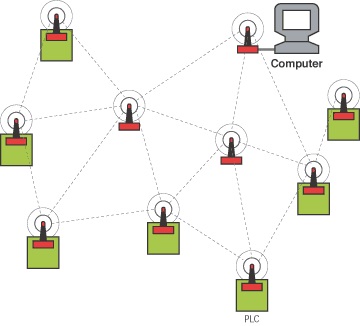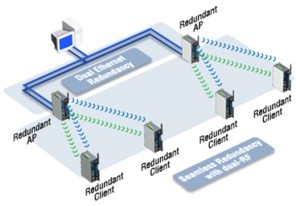The Perks of Network Redundancy: How Redundancy Methods Secures Wireless Network Connectivity
Overview
The uses of wireless networks have flourished throughout the world and with the aid of the Industrial Internet of Things. The IIOT sets its objectives on wireless networks for more mobile collaborations between man and machine to redefine the definition of business. Wireless networking is an ideal approach for productivity because it decreases spending costs compared to old-fashioned wired technology. Companies that adopt the use of wireless technology experience more flexible connections and access in acquiring important data. However, for the sake of reliability, business should not ignore the fact that relying on wireless networking has its risks.

Companies must take caution and be aware that incorporating this technology leaves room for everyday interferences to obstruct important connections from reaching its destination. For example, an agricultural factory uses wireless networking to transfer data for proper maintenance. However, the data is unable to go through to a maintenance manager because there is a 30 story building and other WiFi connections in the way. Interferences occur not only in industrial environments but through everyday situations as well that can potentially meddle with wireless signals. These kinds of inconveniences happen all the time. Miscommunications can lead to a number of problems that leads to a waste of valuable time and money. This article examines a smarter approach by using wireless redundancy to combat these problems without the need to spend it on expensive networking systems.
Leading Causes of Network Failure
Wireless interference can be very inconvenient for companies that need to manage multiple industrial applications daily. There are many reasons why signals get jammed and disrupted from various causes. As a result productions from mass manufactures can come to a stop, and the hassles of repair and maintenance has only just begun with this issue. Common types of interference come from other WiFi networks, walls, and radio frequencies:
 ► Other WiFi networks that are using identical WiFi network channels
► Other WiFi networks that are using identical WiFi network channels
● If two or more networks are using the exact frequency channel as another, they will start to compete who uses more network bandwidth. These problems usually arise in urban environments that are packed with many WiFi networks.
► Walls and floors and physical objects
● Dense and solid materials such as concrete or brick walls can drastically slow down or even block wireless connectivity.
● Buildings, trees, large ships, trains and metal objects and wiring can all obstruct wireless connectivity that creates dead zones.
● A dead zone is an area where wireless connectivity is supposed to work, but doesn’t.
► Radio and Electrical Interferences
● Wireless networking uses devices that operate on an RF range 2.4GHz. However, most devices like microwaves, cordless phones, and Bluetooth systems also operate on the same frequency channel. This ultimately leads to a weaker signal.
● Electrical interference includes refrigerators and motorized systems.
Introducing Network Redundancy
Ensuring maximum reliability in which industrial productions operate smoothly should be top priority. Companies use networks for more efficient ways to connect and manage production levels on a daily basis. The industry has integrated KVM switches over IP connections, and other cable systems to manage data wirelessly. However, like what was previously mentioned above, wireless networking can create a living nightmare for anyone using this technology. Redundancy is most ideal for those mission-critical industrial applications.
Redundancy is a process where duplicate or alternate data paths are created in a network. If a switch fails connectivity, network redundancy puts an alternate or back-up method to access operations. With multiple back-up plans to solve problems when connections are down, redundancy provides a dramatic increase in reliability and connectivity.
 Wireless Mesh Networks
Wireless Mesh Networks
One of the most common redundancy methods is wireless mesh networking. This method is cost effective and efficient for connectivity. Inside this network, numerous amounts of mesh nodes communicate with each other to transport data for the network in larger areas. Mesh nodes consist of three working interfaces called LAN, WAN and mesh. The nodes work through a process called dynamic routing. This method offers very reliable data routing because it allows the routers to select safe and quick paths. Administrators can control how far and fast their connection goes by creating more nodes.
A major advantage for mesh networks is that they are completely wireless. Other wireless systems are still considered wireless but they have to be wired to the internet to transmit signals. Using less wired systems reduces money and maintenance fees. Mesh nodes bring convenience to areas that are lacking in proper Ethernet connections like in outdoor or warehouse type settings. Local configurations around a mesh server experience faster connections because they don’t have to roam back to the main server.

Dual-RF Wireless Technology
The advantages of dual RF wireless technology allow network redundancy without the requirement of changing the original architecture of the LAN. In single RF connections, when one frequency goes down the entire system will be disconnected. However, dual-RF redundancy brings in an alternate frequency to secure connections.
The purpose of wireless networking is to provide efficiency and flexibility to industrial applications. This paper addressed the main obstacles that can prevent the transmission of important data, whether the cause is from radio frequencies from microwaves, cordless phones, metal objects, physical structures and even other WiFi connections using the same frequency channels. Without the aid of wireless networking redundancy methods like mesh networking, these systems will ultimately fail and cost companies valuable time and money for maintenance. Redundancy methods deliver fast, efficient, reliable, and cost effective approaches to combat the problem of wireless network interference and failures.
All Acnodes embedded systems provide wireless network redundancy.




